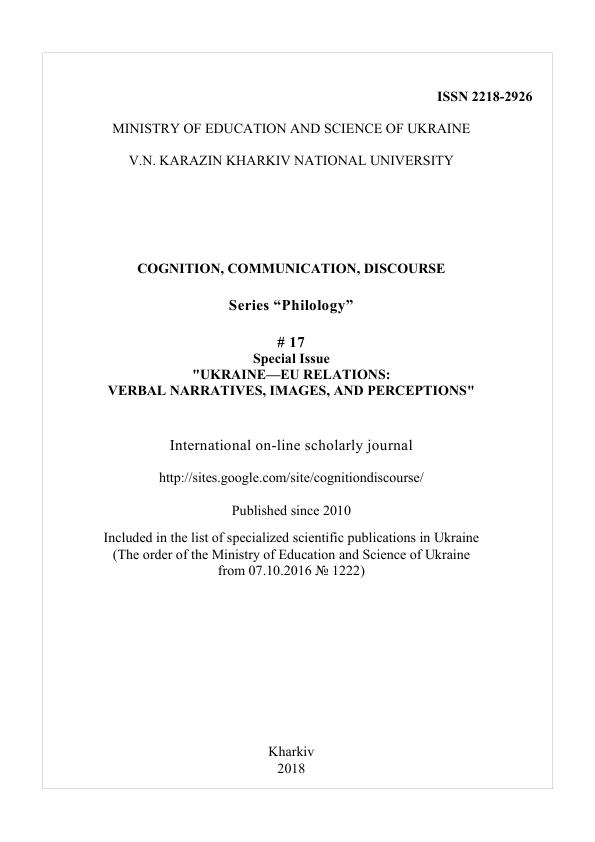Political images and perceptions at the interdisciplinary crossdoards. Introduction to the Special Issue "Ukraine-EU Relations: Verbal Narratives, Images, and Perceptions"
Abstract
This special issue presents findings of the transnational research project “Crisis, Conflict and Critical Diplomacy: EU Perceptions in Ukraine, Israel and Palestine” (C3EU) (2015-2018) focusing on Ukraine-specific results [C3EU, online]. Supported by the Erasmus+ of European Commission, C3EU united experienced and early careers scholars into a research team of 36 who studied and facilitated best practice in EU perceptions research. The results of the project contributed to policy debates on EU global and regional governance and fostered academic-policy-makers' dialogues in Ukraine and the EU. Leading to this extensive outreach to the stakeholders, the C3EU research consortium had consolidated academic excellence by gathering linguistic and non-linguistic information, and producing comprehensive and methodologically rigorous analyses of EU perceptions and narratives in Ukraine and Israel/Palestine reflecting major societal challenges. The articles published in this special issue focused on perceptions and images exposed in narratives on the EU, Ukraine and EU—Ukraine relations are interdisciplinary. They combine methodologies of cognitive and communicative linguistics with the findings of communication and media studies, cultural studies, political science, international relations, and European integration studies.
Downloads
References
C3EU (Crisis, Conflict and Critical Diplomacy: EU Perceptions in Ukraine, Israel and Palestine), Available from: https://jeanmonnet.nz/c3eu/.
Chaban, N., Magdalena, A.-M. (2014). External perceptions of the EU during the Eurozone Sovereign Debt Crisis. European Foreign Affairs Review, 19 (2), 195–220.
Chaban, N., & Holland, M. (eds.) (2014). Communicating Europe in Times of Crisis: External Perceptions of the European Union. Houndmills: Palgrave Macmillan.
Chaban, N., & Holland, M. (eds.) (2018). Shaping the EU’s global strategy: partners and perceptions. Houndsmill: Palgrave McMillan.
Chaban, N., Elgström, O., Kelly S., & Lai S.-Y. (2013). Images of the EU beyond its borders: Issue-specific and regional perceptions of EU power and leadership. Journal of Common Market Studies, 51 (3): 433-451.
Entman, R.M. (2003). Cascading activation: Contesting the White House’s frame after 9/11. Political Communication, 20 (4), 415–432.
Entman, R.M. (2004). Projections of power: framing news, public opinion, and U.S. foreign policy. Chicago: University of Chicago Press.
EU Global Strategy (EUGS) (2016). Available from http://europa.eu/globalstrategy/en/global-strategy-foreign-and-security-policy-european-union
Hall, S. (1997). Representation: cultural representations and signifying practices. London: Thousand Oaks, Calif: Sage, in association with the Open University.
Georgakopoulou, A. (2007). Small stories, interaction and identities. Amstrdam / Philadelphia: John Benjamins.
Hall, S. (1980/2001). Encoding/Decoding. In M.G. Durham and D. Kellner (eds.) Media and Cultural Studies: Keyworks. Oxford: Blackwell, 166-176.
Harnisch, S., Frank, C., & Maull, H.W. (eds.) (2011). Role Theory in International Relations. London and New York: Routledge.
Holsti, K. (1970). National role conceptions in the study of foreign policy’. International Studies Quarterly, 14 (3), 233-309.
Horbyk, R. (2017) Mediated Europes: discourse and power in Ukraine, Russia and Poland during Euromaidan. Published PhD dissertation, Södertön University Doctoral Dissertations.
Lakoff, G., & Johnson, M. (1980). Metaphors we live by. Chicago: University of Chicago Press.
Nadelmann, E. (1990). Global prohibition regimes: The evolution of norms in international society. International Organization, 44 (4): 479–526.
Peeren, E., Horskotte, S. (2007). Introduction: The shock of the other. In S. Horskotte and E. Peeren (eds.). The shock of the other: situations alterities. Amsterdam, New York: Rodopi.
Pickering, M. (2001). Stereotyping: The Politics of Representation. Houndmills: Palgrave Macmillan.
Said, E. W. (1978). Orientalism. London: Penguin.
Zhabotynskaya, S. (2016). Kontseptualnyie metaforyi v rechah Baraka Obamyi i Vladimira Putina (2014–2015) [Conceptual metaphors in the public speeches of Barack Obama and Vladimir Putin (2014–2015)]. Cognition, communication, discourse, 13. (In Russian). Available from: https://sites.google.com/site/cognitiondiscourse/vypusk-no13-2016/zabotinskaa-s-a
Authors, who publish with this journal, accept the following conditions:
The authors reserve the copyright of their work and transfer to the journal the right of the first publication of this work under the terms of the Creative Commons Attribution License (CC BY), which allows other persons to freely distribute a published work with mandatory reference to the authors of the original work and the first publication of the work in this journal.
Authors have the right to enter into separate additional agreements for the non-exclusive dissemination of the work in the form in which it was published by this journal (for example, to post the work in the electronic institutions' repository or to publish as part of a monograph), provided that the link to the first publication of the work in this journal is given.
The journal policy allows and encourages the authors to place the manuscripts on the Internet (for example, in the institutions' repositories or on personal websites), both before the presentation of this manuscript to the editorial board and during review procedure, as it contributes to the creation of productive scientific discussion and positively affects the efficiency and dynamics of citing the published work (see The Effect of Open Access).




